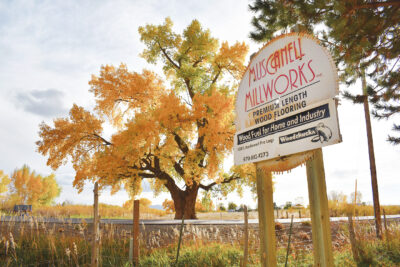North America– North American lumber prices have continued to rise since Russia has invaded Ukraine. Since Vladimir Putin ordered troops to enter Ukraine, prices have increased by 14 percent up to $1,452, putting them just 15 percent below their all-time peak of $1,711 last May.
The U.S. and EU sanctions in response to the invasion are hitting the Russian economy, but such sanctions could pressure lumber prices to go up more. Russia is the largest wood exporter in the world, and its exports reached US$12 billion last year.
Even before the war began, lumber prices were volatile. In January, they fell 15 percent. Since February 1, they’ve soared 55 percent.
Starting this week, price swings will have more room to rise.
De-escalation in the Russia-Ukraine war may not offer much price relief either as several factors have been applying upward pressure. The U.S. housing shortage and a continuing focus on home improvement are keeping demand high. Also, flooding in the key lumber hub of British Columbia last year has kept distribution snarled and supply chains constrained.

Ukraine– Trade with Ukraine has come to a near standstill following the imposition of martial law in Ukraine and draft of men. No change in this situation is expected until an end of the war.
Forestry/wood exports from Russia were not under sanctions at the time of this writing. The main difficulties of wood exporters are linked to payments and transportation.
• The banks that are now under sanctions and will be excluded from SWIFT in the next days (Sberbank, VTB, Otkritie, Sovkombank, Promsvyazbank, Novikombank) represent around half of the Russian banking system. Many exporters are using these banks and have to find other channels to receive foreign currencies.
• Road transportation is hugely disturbed from Russia to Europe. The alternative route via the Baltic Sea is suffering from a shortage of shipping vessels.
EU exports of machinery and furniture to Russia are expected to be much more affected as such.
• Importers using the banks previously described will have the same problems to do their payments. With the additional risk that Russia might place restrictions on foreign payments in Euro/USD.
• Transportation suffers from the same problems previously described.
• Credit agencies have stopped covering Russia and EU/US export finance agencies are not working with Russia anymore.

Russia– Increased sanctions against trading with Russia and difficulty with financial transactions are anticipated to interrupt and re-direct shipments of forest products throughout the world. As a result, trade with Russia will likely decline, impacting long-established international trade flows of forest products.
Countries like China and India, who have reluctantly supported Russia in the conflict, may also be affected by limited trade sanctions. This development would mainly affect China, which relies on the importation of forest products, including logs, wood chips, lumber, pulp, and paper from North America, Europe, Oceania, and Latin America for domestic use.
These world regions are considering expanded sanctions for Russia and countries that directly or indirectly support Russia’s attack on Ukraine.
Russia’s exported forest products were valued at over US$12 billion in 2021, and imports of paper products (mainly) were valued at about US$2 billion. Much of this trade is in jeopardy.
Russia is the largest lumber exporter globally and ranks as the seventh biggest exporter of forest products worldwide. Forest products exports from Russia have increased rapidly in the past five years, led by softwood lumber and paper products.
An estimated 40 percent of exports were destined for China, while the remainder was predominantly shipped to European markets.
Russia has vastly under-utilized forest resources and has the potential to increase timber harvests to supply its domestic industry. To meet increased global demand for forest products, the Russian government recently initiated programs to encourage investments in the sector to both expand/modernize existing manufacturing plants and build greenfield facilities.
However, it is likely that many investments projects in the forest products manufacturing sector in Russia will grind to a halt as the growing list of sanctions and financial transaction restrictions take effect.

Europe– Companies in the European timber industry are increasingly deciding to suspend or restrict trade with Russia or to stop production in Russian plants.
The Association of the German Furniture Industry is expecting a drastic decline in furniture exports to Russia. In 2021, sales of these amounted to €87.5 million.
The President of the Association of German Chambers of Commerce and Industry (DIHK), Peter Adrian, expects the Ukraine war to have serious effects on German-Russian trade relations and energy supply, with Germany accounting for 55 percent for gas, 35 percent for oil and 50 percent of coal is enormously dependent on Russia. In Austria, there are similar concerns. The Austrian Forest Association, the Biomass Association and proPellets Austria recently appealed to the federal government with a 10-point program to make full use of the potential of wood energy as quickly as possible. The usage residues due to increased forest care measures are currently over 250 million m³. That is enough wood for a massive timber construction program including sufficient energy to meet the gas requirements for space heating.
The DIHK President also expects the conflict to have an impact on trade relations between Germany and China. “Russia will try to use its relationship with China to compensate for what will be lost from America and Europe from now on–such as technological supplies from the industrial and mechanical engineering sectors,” he was quoted as saying in published reports.

Indonesia– Container costs continue to rise and this has become critical for furniture exporters, pushing many small and medium-sized enterprises into bankruptcy, Fordaq recently reported. Data compiled by the Indonesian Furniture and Crafts Industry Association (HIMKI) shows the cost of container shipments have risen 900 percent with the current cost for shipping a 40-foot container to the U.S. is US$19,100 whereas in 2020 it was only US$2,000.
The cost for shipping a 20-foot container is US$15,100, up 907 percent from 2020, which was only US$1,500.
Container shipping costs also increased for the EU market +900 percent, Middle East +400 percent, Japan +350 percent, and Australia +500 percent. There are difficulties regarding the availability of containers, especially to America. At these costs it is not profitable to ship the products. It has been estimated by the HIMKI that around 25 percent of the 2,500 businesses registered as HIMKI members have gone bankrupt as a result of the high cost of shipping.

Switzerland– Recently, the Environment Commission of the Swiss Council of States approved the parliamentary initiative “Price recommendations or wood from Swiss forests” by WaldSchweiz President and Councilor of States Daniel Fässler. He demands that the industry can agree on target prices for raw wood harvested in Swiss forests.
Until 2020, questions about the wood market and general framework conditions between Swiss Forests and the Swiss wood industry could be discussed informally in the Swiss Wood Market Commission. The commission also regularly issued price recommendations for logs from Swiss forests. After the Commission got involved at the end of 2019, the Timber Market Commission was dissolved in the summer of 2020.
Since then, the Swiss Forest Owners’ Association has only published historical prices within the scope of the legal possibilities. This is particularly disadvantageous for private forest owners, explained Fässler, because they often have little or no experience in the wood market.
The parliamentary initiative by Fässler wants to create the basis for Swiss forest owners to once again receive guidance on how to determine the amount of wood felled and how to sell their wood. The initiator is convinced that non-binding price recommendations that are published transparently are an important tool for this. Next, the Environment Commission of the National Council will examine the initiative. If the Council also agrees, a bill will be drawn up.

Vietnam– According to Vietnam Customs in January 2022 (the most recent data available at the time of this writing) wood and wood products export turnover amounted to US$1.5 billion, up 8.3 percent compared to December 2021 and 14.3 percent compared to January 2021. In particular, wood products exports reached US$1.15 billion, up 6.8 percent compared to December 2021 and 6 percent compared to January 2021.
Wood and wood products exports to the UK in January 2022 totalled US$30.7 million, up 11.6 percent compared to December 2021 and 48 percent compared to January 2021. The share of exports to the UK accounted for 2 percent of Vietnam’s total wood and wood products export turnover, up 0.5 percent compared to January 2021.
In January 2022, exports of office furniture from Vietnam valued at US$43 million, up 7.5 percent compared to December 2021, but down 10 percent compared to January 2021.
In January 2022, wood and wood products imports into Vietnam reached US$250.1 million, up 13.3 percent compared to December 2021, but down 10.3 percent compared to January 2021.
In January 2022, Vietnam imported 49.2 thousand cubic meters of Pine wood, worth US$15.3 million, down 9.3 percent in volume and 8 percent in value compared to December 2021; compared to January 2021, it increased by 6.7 percent in volume and 59 percent in value.
The imports of wood from Southeast Asia to Vietnam in December 2021 reached 87,000 cubic meters, worth US$29.68 million, down 40 percent in volume and 55 percent in value compared to November 2021 but increased by 1.7 percent in value compared to December 2020. In 2021, Vietnam imported 960,330 cubic meters from Southeast Asia, worth US$338.28 million, up 5 percent in volume and 49 percent in value compared to 2020.









